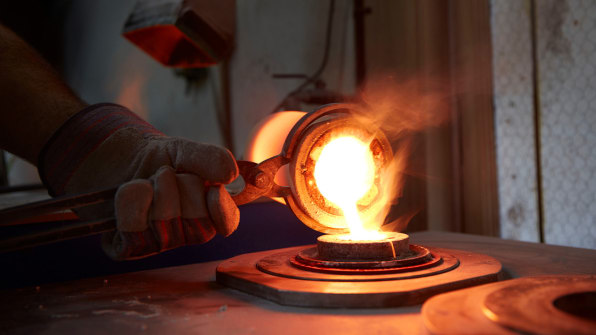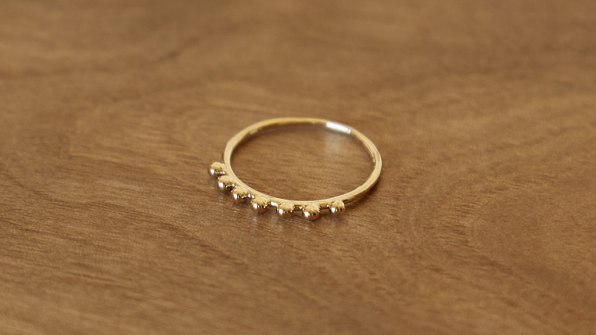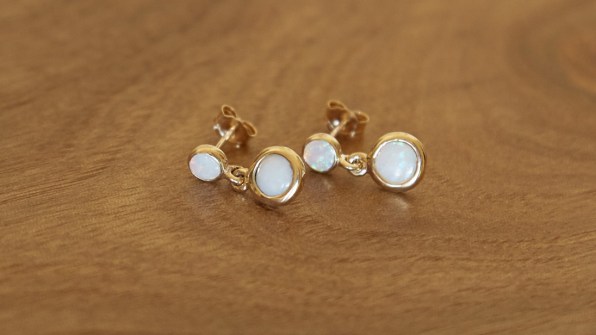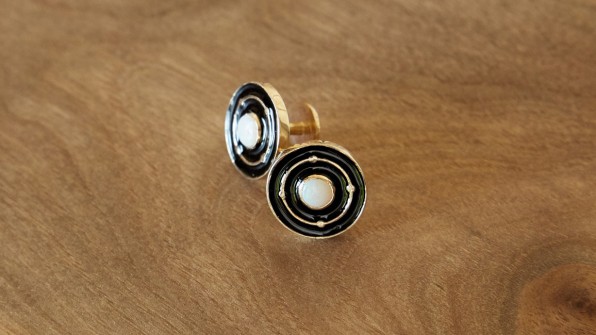In a previous incarnation, the gold used to make a new line of fine jewelry may have been part of a circuit board in your last phone or laptop. The gold is mined from e-waste collected in a national recycling program, turned into gold bars, and delivered to a jewelry manufacturer.
“This has never been done before,” says Nikki Reed, founder of Bayou With Love, a brand that partnered with Dell to make the limited-edition line of rings, bracelets, and other jewelry, called the Circular Collection. (Reed is also an actress known for her roles in the Twilight movies.)
 [Photo: Dell]Dell, working with Goodwill, has collected electronic waste for a decade as part of a larger sustainability plan. But it’s taken time to work with a recycler to develop a process that can sustainably harvest gold from old gadgets, without the harsh chemicals that recyclers have used in the past. The company is now using its recycled gold to create a pilot line of motherboards, and will later use it in more products. The jewelry line is an attempt to draw more attention to the challenge of e-waste.
[Photo: Dell]Dell, working with Goodwill, has collected electronic waste for a decade as part of a larger sustainability plan. But it’s taken time to work with a recycler to develop a process that can sustainably harvest gold from old gadgets, without the harsh chemicals that recyclers have used in the past. The company is now using its recycled gold to create a pilot line of motherboards, and will later use it in more products. The jewelry line is an attempt to draw more attention to the challenge of e-waste.
The world may generate nearly 50 million tons of electronic waste this year; only a tiny fraction of that will be recycled. But the gadgets that end up in the trash, or forgotten in drawers, have valuable materials like gold and silver inside. A 2015 study estimated that consumers were trashing more than $2 billion worth of materials inside e-waste each year in Europe alone.
 [Photo: Dell]Manufacturers, in turn, typically use virgin materials to make new products, despite the environmental cost of mining. Gold is the most malleable metal and the second-best conductor of electricity (it can also easily be made into micron-thin leaf) is well suited for circuit boards. It usually comes from open pit mines, where miners blast rocks with dynamite, drill, crush the ore, and use chemicals to strip out tiny amounts of gold. A typical wedding ring may generate 20 tons of mine waste, which is sometimes dumped into rivers. In the Congo, the proceeds from gold mining, along with mining for tin, tungsten, and tantalum, also found in electronics, has funded years of war.
[Photo: Dell]Manufacturers, in turn, typically use virgin materials to make new products, despite the environmental cost of mining. Gold is the most malleable metal and the second-best conductor of electricity (it can also easily be made into micron-thin leaf) is well suited for circuit boards. It usually comes from open pit mines, where miners blast rocks with dynamite, drill, crush the ore, and use chemicals to strip out tiny amounts of gold. A typical wedding ring may generate 20 tons of mine waste, which is sometimes dumped into rivers. In the Congo, the proceeds from gold mining, along with mining for tin, tungsten, and tantalum, also found in electronics, has funded years of war.
In 2013, Dell set a goal to put 50 million pounds of recycled content back into Dell products by 2020, beginning with plastic; when the company met that goal early, in 2016, it doubled the number to 100 million pounds. Through its recycling program with Goodwill, which accepts electronic waste made by any manufacturer, it now has a steady supply of recycled material, including gold.
“Phones, tablets, and notebooks today have a relatively small amount of gold in each individual device,” says Scott O’Connell, director of environmental affairs and global producer responsibility at Dell. “But in the aggregate, when you’re bringing tens of millions of pounds of electronics into the program that we run, with that scale, you’re able to collect an amount of gold that we can start to put into our supply chain, as well as partnerships like with Nikki.”
 [Photo: Dell]Of course, gold has a long history of being melted and reused; it’s also already possible for someone like a jewelry manufacturer to source recycled gold. The difference, in this case, is that Dell can clearly trace the gold from recycled electronics. “We think that traceability is important to be able to demonstrate not only the ability to be able to tap into these precious materials, but also demonstrate the environmental benefits and savings of that,” O’Connell says. A third-party study for Dell calculated that the recycled gold has 99% less environmental impact than traditionally mined gold.
[Photo: Dell]Of course, gold has a long history of being melted and reused; it’s also already possible for someone like a jewelry manufacturer to source recycled gold. The difference, in this case, is that Dell can clearly trace the gold from recycled electronics. “We think that traceability is important to be able to demonstrate not only the ability to be able to tap into these precious materials, but also demonstrate the environmental benefits and savings of that,” O’Connell says. A third-party study for Dell calculated that the recycled gold has 99% less environmental impact than traditionally mined gold.
The closed-loop gold will be used to manufacture a pilot line of around six million new motherboards, along with the jewelry line. Initially, the recycled gold will be slightly more expensive for Dell to use in its electronics. “Right now, with the pilot, it’s a slight cost increase because it’s the first time we’ve done this in our supply chain,” he says. “But like plastics, we anticipate as we scale, that we’ll be able to get this down to parity or better.”
 [Photo: Dell]To scale up to use the gold in more of its products, it will be key for consumers to recycle electronics at greater rates. The jewelry line is meant to make the need for that recycling more visible. “I think in order to make this more than a blip on the radar, as a lot of these things have been–you know, with sustainable fashion, and conscious consuming–in order to make this more than a trend, we have to come up with new ways to harness people’s attention and really get them to see that this is the only way forward,” says Reed.
[Photo: Dell]To scale up to use the gold in more of its products, it will be key for consumers to recycle electronics at greater rates. The jewelry line is meant to make the need for that recycling more visible. “I think in order to make this more than a blip on the radar, as a lot of these things have been–you know, with sustainable fashion, and conscious consuming–in order to make this more than a trend, we have to come up with new ways to harness people’s attention and really get them to see that this is the only way forward,” says Reed.
The Circular Collection’s name and the shape of the jewelry reference the circular economy, an approach to using materials in closed-loop cycles. The pieces, in 14- and 24-karat gold, are also meant to last, rather than being fast fashion. “It’s important to think about how we consume, but recycling comes in many forms, and one of those forms is passing down your family heirlooms,” says Reed.
“I’m hoping this really helps reconfigure the way people view buying sustainable products,” she says.
Comments
Post a Comment